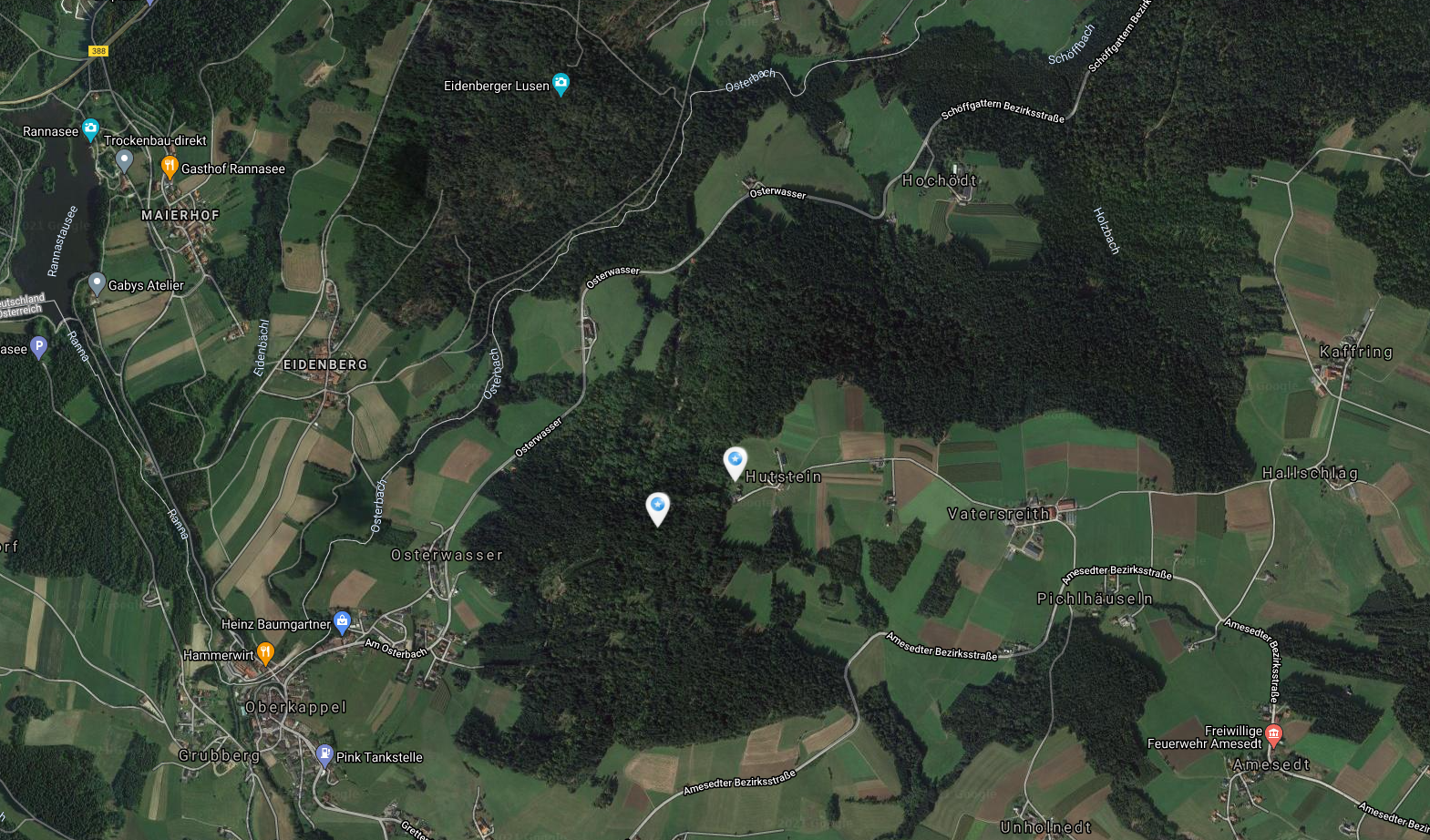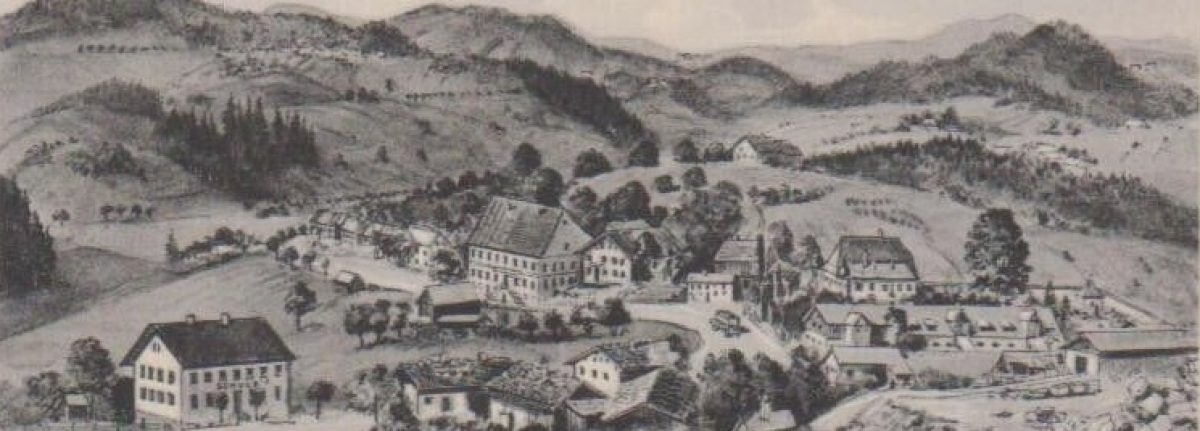A brief history of the Hutsteiner family
The Hutstein was first mentioned in documents in 1509 when Tameln (=Thomas) paid taxes to the Rannariedl lordship on Huestain from one fief. Over time, this became a small hamlet close to the Hutstein rock and known as hamlet Hutstein, with a farm belonging to the Rannariedl dominion and another farm belonging to the Falkenstein dominion and much later with some additional houses.
I.2 Once upon a time frame | HUTSTEIN Origins
Obviously the ancestry of the Hutsteiner families can now be traced back to the inhabitants of this hamlet, which apparently belonged to the parish of Pfarrkirchen im Mühlviertel and is located just across the border in Upper Austria.
I.3 One single origin | HUTSTEIN Origins

Interestingly, the hamlet of Hutstein had two fiefs, the first of which was under the rule of Rannariedl from 1509, the second to the rule of Falkenstein, which was documented from 1537. Both fiefdoms were of the same size. Likely the first fiefdom was not divided as both were subject to different lords. We can assume that two different families sat on these two fiefdoms, whose descendants later received the surname Hutsteiner, but possibly no direct family relationship existed.
The first explicit documentary recording of the family name Hutsteiner took place in 1544 when Lienhard Huetstainer asked for permission to build a mill on the Osterbach near Messnerschlag. This Lienhard occurred in 1560 in a dispute with the millers of Wegscheid. The next Hutsteiner is mentioned in 1581 when a tax document from Rannariedl recorded Steffan Hutsteiner, the successor of Georg.
The Hutsteiner family name finally established at the beginning of the 17th century. Before that the name appears very rarely in the existing documents, although many other family names have already been used, so that we have to assume that a stroke of luck in history has made the name survive the times.
Nevertheless, the Hutsteiner families continued to expand in the Mühlviertel / Upper Austria and Lower Bavaria / Hochstift Passau areas by the middle of the 17th century.
Another important record of the family name took place on September 1st, 1644, as Ferdinand Herberstain, priest of Soc. Jesu and Rector of the Imperial College of Linz, landlord of the Ottensheim dominion, gave Andreas Huetstainer, citizen and provost of Pfarrkirchen, various tithes in Pfarrkirchen and Sarleinsbach parish as fiefs, and notarized a certain social rise of an Hutsteiner.
Meanwhile, one Hutsteiner left the region and moved to Saxonia, likely due to religious persecution.
From 1638, a Michael Huetstainer appears in the court files of the Wiesenburg office in Saxony and from 1641 in the protestant parish registers of Kirchberg near Zwickau in Saxony, who certainly immigrated in Hartmannsdorf near Kirchberg, as there were no further entries in the court books of any Hutsteiners in this area recorded before 1638. Likely he was the Michael Hutsteiner mentioned 1626 in Hofkirchen i.M., Upper Austria.
IV.1.3 An Exulant | HUTSTEIN Origins
If you take a closer look at the history of this village of Hartmannsdorf, it is noticeable that around 1633 it was almost extinct due to the pest plague. It was reported that total of 8 families had survived only. During this period, protestants were also expelled from the Habsburg lands, who were accepted by the Elector in Saxony and settled around the Ore Mountains. Unfortunately, it has not yet been possible to find this direct connection to Upper Austria, especially because the Kirchberg church records are under lock still.
But there is a certain probability because Michael Hutsteiner is sometimes called “Huet” or “Huettenstainer” in Saxony, which was the original name of Hutsteiner in the land of the Rannariedl and Falkenstein dominions and etymologically indicates an ancestry from the Bavarian-speaking area. As he is also referred to as Huettenstainer, which may specifically refer to the name of the hamlet Huettenstain (Hutstein) in the Urbar of Falkenstein from 1607. In addition, in Upper Austria (e.g. in Freistadt) protestant priests from Saxony were active as missionaries in the decades before the expulsion.
Looking at the available court documents from Wiesenburg, it is noticeable that Michael Hutsteiner, a shoemaker, made several purchases around 1640, which suggests a certain level of prosperity. This in turn also matches the copies from Freistadt, the only town in the Mühlviertel and the region where our hamlet Hutstein is located, that apparently many better-off residents left the country with the first wave of displaced persons.
It remains to be mentioned that already processed files in Saxony nowadays contain a note about Michael Hutsteiner that his first wedding was in 1615. The origin of this information could not yet be determined, but is probably in the court documents, e.g. as a birth letter of one of his descendants or any guild letter.
The great-grandson of Michael Hutsteiner, who immigrated to Saxony – also Michael – later came to Dillenburg, Hessen-Nassau, around 1734. Likely he came along with his uncle Georg Hutsteiner to neighbouring city Wetzlar, where he obviously learned his profession healer from him. Since Georg probably had some ties to the military and the court in Dresden, he must have been sent to Hessen as a support for the saxonian delegates in Wetzlar at the Imperial chamber court.
A few years later his uncle Christian was stationed with the Saxon army in Warsaw, where he was promoted to the Saxon travel cashier. From 1763, when Saxony had to give up royal dignity in Poland, he returned and founded a family from which a well-known artillery colonel, Christian Heinrich v. Huthsteiner, emerged, who fought first for and later against Napoleon.
Back to Michael Hutsteiner in Dillenburg: he became the ancestor of most of the protestant Huthsteiners still known today – often spelled with ‘th’ from then on – in Hessen-Nassau and neighbouring areas and of most of the Hut(h)steiner families living in the USA today.
III.2.1 From Saxony to Hesse | HUTSTEIN Origins
It is important to list other Hutstein families whose ancestry has not yet been clarified: from 1713 on, this includes a family of Johann Adam Hutstein, who had descendants in the Bad Schwalbach region and their occupation often were shepherds and of catholic religion. Presumably he is a descendant of Carl Hutsteiner from Budweis, son of Vitus Hutsteiner, who appeared around 1670 in Martinsthal, Rheingau. All of the following families appear in the vicinity north of Marthinsthal, which means that a coincidence probably can be ruled out. However, there is still no written evidence of these descendants.
In addition, there was at least one family in Geldern around 1634, in the neighbourhood of the Netherlands, in which a Hutstein family can also be found. It can be assumed, however, that this family, like the Jewish families of same name, either got the surname independently or, most likely, got this name by chance due to a spelling mistake in the records, perhaps derived from “Utstein”. Perhaps further research will show whether there are any connections to the extended family from the Upper Austrian Mühlviertel.
As a final result it can be stated today that all – except the Jewish Hutstein families – have their origin in this small hamlet of Hutstein in Upper Austria founded between 1488 and 1509.
